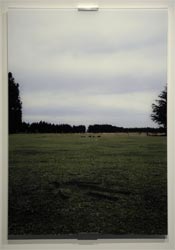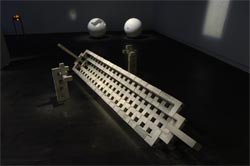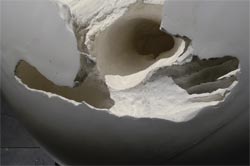Landscape Portrait Prelude 2006 digital print on acrylic © Clare Noonan
Foundation Study .01 Craft 2006 concrete © Grant Wylie
In the Round (detail) 2006 plaster © Phil Murray
The Canterbury high country, that sweep of broken and steep terrain along the Southern Alps, is an isolated place of mountains, foothills, lakes and rivers. The romance of the area has long been an inspiration for artists: many of New Zealand’s well-known works of art evoke the beauty of this landscape.
When Samuel Butler (1835–1902) arrived in Canterbury in 1859 he recorded his impressions in his memoirs and in letters home The relentless, blustery nor’westers, for example, he described as:
[…] a very remarkable feature in the climate of this settlement. They are excessively violent, sometimes shaking the very house; hot, dry, from having already poured out their moisture, and enervating like the Italian sirocco. […] During a nor’wester, the sand on the river-bed is blinding, filling eyes, nose, and ears, and stinging sharply every exposed part.
Nearly one hundred years after Butler’s sojourn as a colonial run-holder on his Mesopotamia sheep station in the Rangitata, Bill Sutton painted Dry September (1949,collection of Christchurch Art Gallery Te Puna o Waiwhetu) and Nor Wester in the Cemetery (1950,collection of Auckland Art Gallery Toi o Tamaki). These works are both testament to the enduring power of this landscape and examples of early Canterbury Regionalism.
Today Christchurch actively nurtures artistic excellence, with many young artists training and starting their careers here before gaining further education and exhibiting experiences nationally and abroad. The exhibition Out of Erewhon: New Directions in Canterbury Art suggests a cohesive survey on the state of current art practice in Canterbury. In some ways it achieves that premise by bringing together a group of fourteen artists who have consistently stayed on the radar of the Christchurch, national and international arts scenes, making work that is inventive, experimental and engaging. The exhibition does not, however, purport to offer a complete analysis of Christchurch’s recent artistic energy, or a purely parochial view.
The exhibition takes it title from Samuel Butler’s novel Erewhon, first published in 1872. (‘Erewhon’ is almost a reversal of the word ‘nowhere’.) Set in the Canterbury high country, the book was inspired by the time Butler spent living in the Rangitata. Out of Erewhon is loosely themed around this novel, which is an intriguing example of early fantasy fiction, drawing upon Victorian interest in Darwinism, the role of machines in society, pioneer exploration and a yearning for utopianism. In fact, Butler’s Erewhonian civilisation is an early precursor of later science fiction writing that employs the notions of utopia (good place, or no place) and heretopia (other place, or place of differences).
The fourteen Out of Erewhon artists have made diverse work that is consistently sculptural in nature, offering aesthetic investigations into the power of imagination and play, the body, technology, the landscape and notions of social and cultural exploration. Many of the artists studied in the sculpture department of the University of Canterbury School of Fine Arts. The rigorous training given there over the last ten years is due largely to sculptor Andrew Drummond, whose critical pedagogy encourages individual students to confront their own consciousness, to continuously ask questions and to relentlessly seek knowledge beyond surface meaning. The technical and conceptual skills learned in the department are reflected in many of these pieces – an attuned sensibility to proportion, the importance of materials as a metaphorical tool and the integration of corporeal concepts in relation to how people interact and receive their work.
Out of Erewhon is contemporary, yet an edge of history is still discernible, with echoes of dream, memory and imagination interweaving to create a fluid synergy between each piece. Landscapes both real and imagined appear in the mediums of photography, film and assemblage, evoking the importance of place and how its influence can extend beyond the confines of Regionalism. Notions of body and self in relation to the world, of identity, social ritual and navigation of individual experiences and views reveal that Canterbury art is far from existing in a vacuum of nowhere, but rather operates from a spirited constancy of vision.
Text by Jennifer Hay


